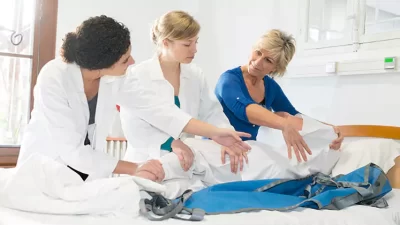Menopause occurs 12 months after your last period and it is the change or transition that every woman goes through. The average onset of menopause is 51, but some women can experience it sooner or even later. Regardless of the age of onset, menopause brings a wide array of symptoms besides night sweats and hot flashes. Menopause and Joint Pain is a common occurrence among menopausal women and this article aims to discuss this relationship.
Why menopausal women have joint pain? Keep reading to find out!
What Causes Joint Pain in Menopause?
According to a study published in the journal Climacteric, aches and stiff joints were the most frequently reported symptom of menopause. Variables that were significantly linked to bothersome joint pain were high BMI, negative mood, unemployment, and the overall menopause transition.
As you can see, joint pain is one of the most common symptoms of menopause and you are probably wondering about the link between the two. Just like with other symptoms you experience during this time, it all comes down to estrogen. As you enter menopause, levels of this hormone start declining. The underlying mechanism through which estrogen is associated with joint pain is unclear.
While scientists are investigating this link, they speculate it could be due to the fact that estrogen plays a role in pain pathways in the body.
Indeed, researchers at the University of Kansas Medical Center discovered that estrogen modulates pain by affecting levels of BMP4 protein which ensures you have the right number of pain-sensing nerves. Basically, higher estrogen levels are linked to lower BMP4 and, thereby, less pain. During and after menopause, lower estrogen leads to higher BMP4 count and more pain.
The Arthritis Research and Therapy published results of the study which investigated the role of estrogen levels in osteoarthritis (OA) risk in women. Osteoarthritis is one of the most common types of arthritis and it primarily affects women who are experiencing menopause.
Scientists found that development of OA is linked to estrogen deficiency. Estrogen plays a role in homeostasis of joint tissues and, thereby, affects the health of your joints. This hormone influences their metabolism through multiple complex molecular mechanisms.
Dehydration Plays a Role, Too

Dehydration can also cause joint pain. How? When joint cartilages are well-hydrated, the friction rate between bones is lower, unlike in dehydrated cartilages. Due to higher friction, dehydration accelerates the process of joint damage.
In dehydrated cartilage the discs, which act as shock absorbers that prevent bones from rubbing together, don’t function properly because their cushioning ability is based on the water content. Why is this related to menopause? The answer is simple, estrogen is important for regulating fluid levels in your body. When estrogen levels decline, your body isn’t able to retain water efficiently.
Dehydration doesn’t only contribute to joint pain, it can intensify it. Evidence shows that the more dehydrated you are, the more intense feeling of pain. Now you have yet another reason to stay hydrated throughout the day and focus on intake of water primarily.
Overweight/Obesity
Hormonal changes during perimenopause contribute to increased abdominal obesity in menopause. Weight gain is yet another factor in the relationship between menopause and joint pain. Excess weight puts additional stress on weight-bearing joints. Of course, more stress leads to higher susceptibility to pain.
It is also important to mention that inflammatory factors associated with weight gain may contribute to poor joint health. When a menopausal woman experiences joint pain her physician advises to keep weight in a healthy range and work to shed a few pounds in order to manage this problem. In fact, weight loss is a smart strategy for management of other symptoms of menopause as well.
Depression

Depression is yet another common symptom of menopause. Hormonal fluctuations, the intensity of other symptoms, and life changes that occur during this time in your life can cause stress, anxiety, and menopause. Depression is more than a feeling of sadness, it is indicated by numerous physical and psychological symptoms. One study found that depression is also associated with a headache, backache, and pain in muscles and joints.
Due to the fact that depression and pain share common neurochemical pathways (both are influenced by serotonin and norepinephrine), it comes as no wonder they usually occur together. This just goes to show that menopause symptoms are all connected, even though they seem entirely unrelated to us.
Tips To Relieve Joint Pain
Pain and discomfort in your joints limit the flexibility and range of motions. Things you used to do with ease become burdensome and difficult to complete. The quality of life suffers significantly thus illustrating that effects of joint pain go well beyond discomfort in knees or hips. This problem affects other aspects of your life. That said, you can manage joint pain and reduce its severity with these tips:
- Manage Weight – As mentioned above, overweight/obesity adds more pressure to your joints and causes pain
- Exercise – Although the first instinct tells you to stay in bed until the joint pain goes away, that’s not the smartest idea. In fact, it would only aggravate the pain. The solution is to do low-impact activities that don’t stress your joints too much. Plus, physical activity can help you lose weight
- Hot and Cold – Apply hot compresses to relieve stiffness in your joints or ice packs to alleviate the pain. To most people, the combination of hot and cold therapy works the best
- Meditate – Meditation won’t magically take away the pain, but it can help you reduce stress and enable you to cope with pain better
- Get a Massage – Besides soothing and de-stressing effects of massage, it also improves blood flow and range of motion

See More: Joint Pain In Women: Causes, Treatment And More
Conclusion
Joint pain is a common symptom of menopause and it occurs due to multiple reasons. Besides hormonal fluctuations, dehydration, weight gain, and depression also play a role in developing pain and discomfort in your joints. A healthy lifestyle characterized by a well-balanced diet and regular low-impact exercise routines is a great way to manage joint pain and improve the overall quality of life.







 This article changed my life!
This article changed my life! This article was informative.
This article was informative. I have a medical question.
I have a medical question.
 This article contains incorrect information.
This article contains incorrect information. This article doesn’t have the information I’m looking for.
This article doesn’t have the information I’m looking for.